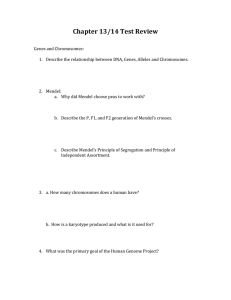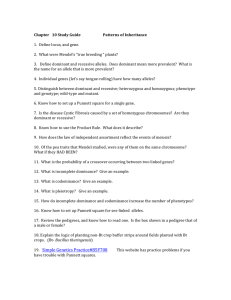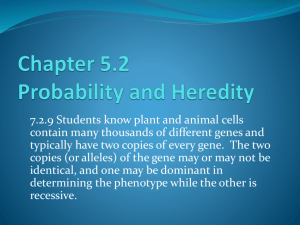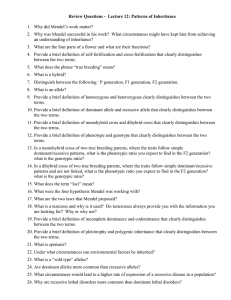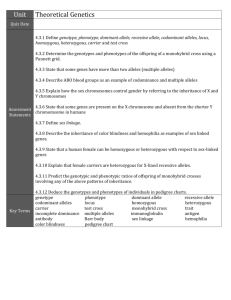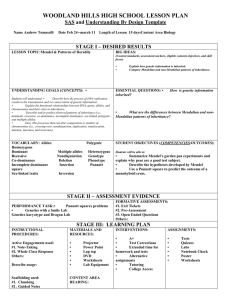FIGURE 8.1
advertisement
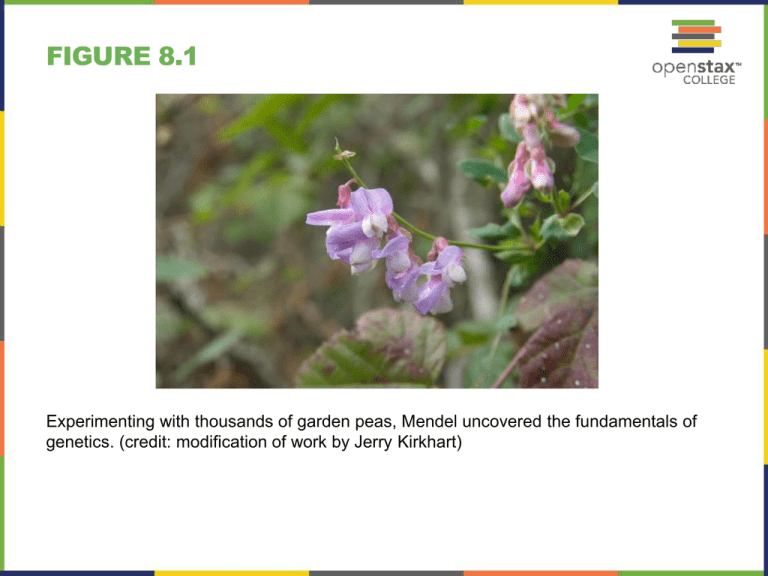
FIGURE 8.1 Experimenting with thousands of garden peas, Mendel uncovered the fundamentals of genetics. (credit: modification of work by Jerry Kirkhart) FIGURE 8.2 Johann Gregor Mendel set the framework for the study of genetics. FIGURE 8.3 Mendel’s process for performing crosses included examining flower color. FIGURE 8.4 Mendel identified seven pea plant characteristics. FIGURE 8.5 Phenotypes are physical expressions of traits that are transmitted by alleles. Capital letters represent dominant alleles and lowercase letters represent recessive alleles. The phenotypic ratios are the ratios of visible characteristics. The genotypic ratios are the ratios of gene combinations in the offspring, and these are not always distinguishable in the phenotypes. FIGURE 8.7 The first division in meiosis is shown. FIGURE 8.8 A test cross can be performed to determine whether an organism expressing a dominant trait is a homozygote or a heterozygote. FIGURE 8.9 This Punnett square shows the cross between plants with yellow seeds and green seeds. The cross between the true-breeding P plants produces F1 heterozygotes that can be self-fertilized. The self-cross of the F1 generation can be analyzed with a Punnett square to predict the genotypes of the F2 generation. Given an inheritance pattern of dominant–recessive, the genotypic and phenotypic ratios can then be determined. FIGURE 8.10 A dihybrid cross in pea plants involves the genes for seed color and texture. The P cross produces F1 offspring that are all heterozygous for both characteristics. The resulting 9:3:3:1 F2 phenotypic ratio is obtained using a Punnett square. FIGURE 8.11 The random segregation into daughter nuclei that happens during the first division in meiosis can lead to a variety of possible genetic arrangements. FIGURE 8.6 The allele for albinism, expressed here in humans, is recessive. Both of this child’s parents carried the recessive allele. FIGURE 8.12 These pink flowers of a heterozygote snapdragon result from incomplete dominance. (credit: “storebukkebruse”/Flickr) FIGURE 8.14 Inheritance of the ABO blood system in humans is shown. Such traits which multiple alleles in a population show Co-Dominance. FIGURE 8.13 This Punnet square shows an AB/AB blood type cross FIGURE 8.15 In Drosophila, the gene for eye color is located on the X chromosome. Red eye color is wild-type and is dominant to white eye color. Such genes are called sex linked genes. FIGURE 8.16 Crosses involving sex-linked traits often give rise to different phenotypes for the different sexes of offspring, as is the case for this cross involving red and white eye color in Drosophila. In the diagram, w is the white-eye mutant allele and W is the wildtype, red-eye allele. Sex linked inheritance is more often seen in males as they are hemizygous (have only one X) so the gene on the X chromosome inherited from mother is expressed as fathers give Y to the sons and X to daughters FIGURE 8.17 The process of crossover, or recombination, occurs when two homologous chromosomes align and exchange a segment of genetic material. Crossing over can unlink linked genes. Cases in which inheritance for a characteristic like skin color or human height depend on the combined effects of numerous genes are called polygenic inheritance. FIGURE 8.18 In this example of epistasis, one gene (C) masks the expression of another (A) for coat color. When the C allele is present, coat color is expressed; when it is absent (cc), no coat color is expressed. Coat color depends on the A gene, which shows dominance, with the recessive homozygote showing a different phenotype than the heterozygote or dominant homozygote.
